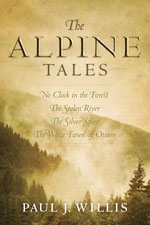They remained on their backs and watched the sky and found their breath and felt the turf all cool beneath their shoulders. It was a good place, a quiet place, a place to hear the breeze and touch the sun, to watch lupine bloom and lupine wither, to taste the snow and sniff the rain, and having done all this, to listen to the meadow streams fall down into the forest. It was their place, and not their place, which is why they could stay, and why they had to leave.
—from The Alpine Tales, Book 1
 This quartet of eco-fantasy novels was published by WordFarm in 2010. Together they tell a single story. Set in a mythic version of the Cascades of the Pacific Northwest, the tales combine the real and the fantastic through every season of the mountain year. The first two tales, No Clock in the Forest and The Stolen River, have been published separately by Crossway Books and then Avon Books in earlier versions. The last two tales, The Silver Spire and The White Fawn of Otium, are published in The Alpine Tales for the first time.
This quartet of eco-fantasy novels was published by WordFarm in 2010. Together they tell a single story. Set in a mythic version of the Cascades of the Pacific Northwest, the tales combine the real and the fantastic through every season of the mountain year. The first two tales, No Clock in the Forest and The Stolen River, have been published separately by Crossway Books and then Avon Books in earlier versions. The last two tales, The Silver Spire and The White Fawn of Otium, are published in The Alpine Tales for the first time.
